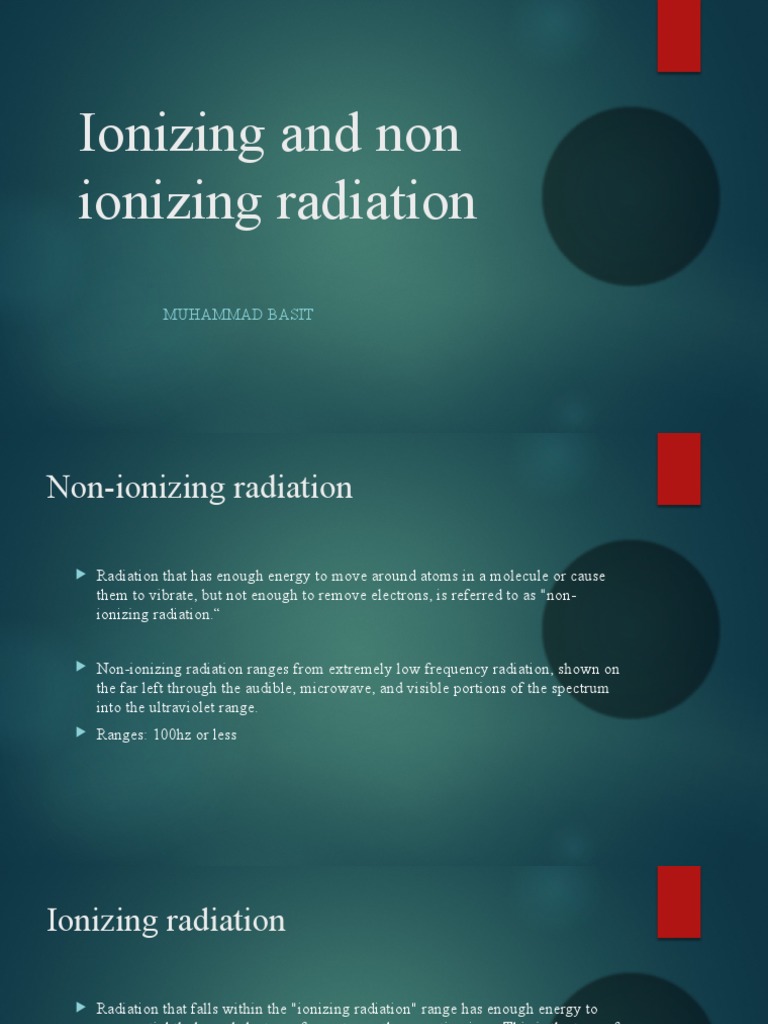Radiation occupies a pivotal position in both the scientific community and public discourse, influencing various sectors, from medicine to energy production. Understanding the distinctions between ionizing and non-ionizing radiation is crucial for grasping their implications across multiple disciplines. This article delves into the characteristics, types, applications, and health effects of both ionizing and non-ionizing radiation.
1. Defining Radiation
Radiation is defined as the emission or transmission of energy through space or a material medium in the form of waves or particles. It is categorized primarily into two types: ionizing and non-ionizing. The fundamental difference lies in the energy levels of the emitted radiation and its potential biological effects at the molecular level.
2. Ionizing Radiation
Ionizing radiation consists of high-energy photons or particles that possess sufficient energy to ionize atoms, i.e., to disrupt their electronic structure. This form of radiation is characterized by its ability to remove tightly bound electrons from atoms, leading to the formation of ions. Its energy is typically greater than 10 electronvolts (eV).
2.1 Types of Ionizing Radiation
There are four primary types of ionizing radiation:
- Alpha Particles: These are heavy particles consisting of two protons and two neutrons. Alpha radiation has low penetration power and can be stopped by a sheet of paper or the outer layer of human skin.
- Beta Particles: Beta radiation consists of high-energy, high-speed electrons or positrons emitted by certain types of radioactive nuclei. Beta particles can penetrate biological tissues to a moderate extent and require materials like plastic or glass for effective shielding.
- Gamma Rays: Gamma radiation is electromagnetic radiation of high frequency and short wavelength. Gamma rays penetrate deeply and necessitate dense materials, such as lead or several centimeters of concrete, for effective attenuation.
- X-rays: Similar to gamma rays but typically with lower energy, X-rays are produced by electron transitions and are widely used in medical imaging and treatments.
2.2 Applications of Ionizing Radiation
Ionizing radiation plays a significant role in multiple industries:
- Medical Applications: It is integral to diagnostic imaging (e.g., X-rays and CT scans) and cancer therapy (e.g., radiation oncology).
- Industrial Uses: Ionizing radiation is invaluable in non-destructive testing, radiography, and sterilization processes.
- Scientific Research: It is utilized in various fields, including nuclear physics and radiochemistry, to advance our understanding of matter and fundamental interactions.
2.3 Health Effects of Ionizing Radiation
The biological effects of ionizing radiation are a topic of considerable concern due to its potential to damage cellular structures and genetic material. Short-term exposure can lead to acute radiation syndrome (ARS), while long-term exposure is associated with an increased risk of cancer and genetic mutations. Safety protocols and limit regulations are imperative to mitigate these health risks.
3. Non-Ionizing Radiation
Non-ionizing radiation encompasses lower-energy electromagnetic radiation that lacks the energy required to ionize atoms. This form of radiation is generally considered safe at typical exposure levels, although concerns about excessive exposure have arisen in certain contexts.
3.1 Types of Non-Ionizing Radiation
Non-ionizing radiation can be further classified into several types:
- Radio Waves: These have the longest wavelengths within the electromagnetic spectrum and are used for communication, including television and radio broadcasts.
- Microwaves: With intermediate wavelengths, microwaves are utilized in cooking, telecommunications, and radar technology.
- Infrared Radiation: Infrared radiation, commonly associated with heat, has applications in thermal imaging, optical fibers, and various heating technologies.
- Visible Light: This is the portion of the electromagnetic spectrum that is perceivable to the human eye, crucial for vision and various artistic expressions.
- Ultraviolet (UV) Radiation: Although UV radiation has certain ionizing properties, it is largely classified as non-ionizing. It has applications in sterilization and disinfection but poses risks of skin damage and cancer upon excessive exposure.
3.2 Applications of Non-Ionizing Radiation
Non-ionizing radiation finds extensive use in modern society:
- Medical Technologies: Used in imaging techniques such as MRI and in the therapeutic domain for laser treatments.
- Telecommunications: Essential in wireless communication technologies, including cellular phones and Wi-Fi.
- Consumer Electronics: Found in everyday devices such as remote controls, LED lighting, and many home appliances.
3.3 Health Effects of Non-Ionizing Radiation
The adverse health effects associated with non-ionizing radiation are comparatively less severe; however, prolonged exposure to high levels of certain types, particularly UV radiation, can lead to skin and eye damage. Ongoing research assesses the potential risks linked to prolonged exposure to radiofrequency fields.
4. Conclusion
The distinctions between ionizing and non-ionizing radiation are paramount across various domains, underscoring the need for informed understanding and cautious management of exposure levels. As technology advances, increasing reliance on various forms of radiation necessitates continuous research into their effects on health and safety protocols to optimize their beneficial uses while mitigating risks. An ongoing dialogue about radiation is essential, fostering public awareness and education surrounding its role and safety in our lives.












